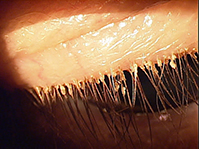| |
|
| Vol. 1, #06 • Thursday, October 22, 2020 |
|
|
|
|
| |
|
Review's Chief Clinical Editor
Paul M. Karpecki, OD, FAAO
Provides you with cutting-edge clinical strategies for optimal management of ocular surface disease and beyond.
|
|
|
|
|
|
 |
| Classic collarettes in a case of Demodex blepharitis. |
|
Blepharitis can affect the entire eyelid, including the meibomian glands, and lead to evaporative dry eye disease (DED). So it is imperative to control the pathogens that may be involved, in addition to treating the resulting inflammation and DED.
There are two infectious forms of blepharitis, and both can lead to DED:
1. Demodex blepharitis. Demodex are mites that are normally present on a healthy human being. However, the eyelids can become infested by D. folliculorum, leading to lash loss, damaged meibomian glands, and eventual atrophy, hyperemia, and DED. Patients with this form of blepharitis will often complain of itching of the eyelid margins. Collarettes are a pathognomonic sign of Demodex blepharitis and appear as a clear or white sleeve at the base of the lashes. This is typically the tail of the mite with the head inside the follicle, although it sometimes can be debris and discharge strewn out of the follicle. Eventually the Demodex mites will reach the meibomian glands, and lead to atrophy and DED. Demodex (usually Demodex brevis) is also a culprit in rosacea. Treatment involves high-concentration tea tree oil (which can be uncomfortable for patients), mechanical blepharoexfoliation (e.g., BlephEx), low light level therapy (LLLT) and intense pulsed light therapy (IPL). Long-term maintenance with 3 to 5% tea tree in a lid scrub may reduce the time to recurrence.
2. Staphylococcal blepharitis. Staphylococcal epidermidis and Staph. aureus are normal flora of the eyelids, but quorum sensing can lead to an imbalance triggering bacterial blepharitis. This can eventually lead to MGD, inflammation, and DED.1 Patients with this form of blepharitis will often complain about mattering and debris on the lashes, in addition to gritty eyes and hyperemia of the lid margins. Diagnosis is evident on the slit lamp exam by the presence of a yellowish discharge or debris throughout the lashes. It can also become apparent by a biofilm sheen on the lid margins. Management would begin with antibiotic drops or ointment, or a combination agent, blepharoexfoliation, and lid hygiene. Lid hygiene may include hypochlorous acid or surfactant lid scrubs to address the outbreak and for maintenance to prevent recurrences.
If DED is present in addition to blepharitis, patients may experience significant or frequent dry eye flareups. In addition to treating the blepharitis, the inflammation, MGD, and dry eye disease must be addressed.
|
|
|
|
KEY TAKEAWAY: When blepharitis is present, it is imperative to control the pathogens that may be involved, in addition to treating the resulting inflammation and DED.
1. Rynerson JM, Perry HD. DEBS - a unification theory for dry eye and blepharitis. Clin Oph-thalmol. 2016 Dec 9;10:2455-2467.
|
|
|
|
| Supported by an independent medical grant from Kala Pharmaceuticals |
|
| |
| |
Review of Optometry® is published by the Review Group, a Division of Jobson Medical Information LLC (JMI), 19 Campus Boulevard, Newtown Square, PA 19073.
To subscribe to other JMI newsletters or to manage your subscription, click here.
To change your email address, reply to this email. Write "change of address" in the subject line. Make sure to provide us with your old and new address.
To ensure delivery, please be sure to add revoptom@lists.jobsonmail.com to your address book or safe senders list.
Click here if you do not want to receive future emails from Review of Optometry. |
|
|
|
|
|
|
|
|